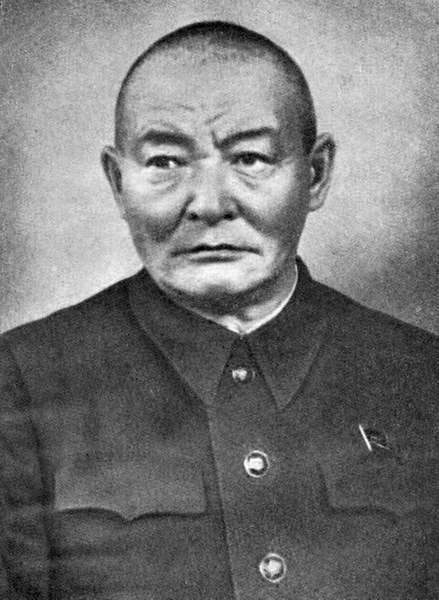(Post-revolution) Tag: Visual edit |
(WWII) Tag: Visual edit |
||
| (2 intermediate revisions by the same user not shown) | |||
| Line 9: | Line 9: | ||
Choibalsan joined a revolutionary group located in the consular quarter of Örgöö (now Ulaanbaatar) that included the teacher [[Dogsomyn Bodoo]], the lama [[Darijavyn Losol]], and some low-ranking officials. He first met [[Damdin Sükhbaatar|Sükhbaatar]] in the fall of 1919, and his group merged with Sükhbaatar's group in June 1920 to form the MPRP. Three days later, he set off to Russia with [[Soliin Danzan]] to get support from the [[Communist Party of the Soviet Union|Bolsheviks]]. On July 22, his group met Sükhbaatar and other party members in Verkheudinsk (now Ulaan-Üde) and then went to Irkutsk. He stayed in Irkutsk with Sükhbaatar while other party members visited [[Moscow]] or returned to Örgöö early.<ref name=":03" /><sup>:278–82</sup> | Choibalsan joined a revolutionary group located in the consular quarter of Örgöö (now Ulaanbaatar) that included the teacher [[Dogsomyn Bodoo]], the lama [[Darijavyn Losol]], and some low-ranking officials. He first met [[Damdin Sükhbaatar|Sükhbaatar]] in the fall of 1919, and his group merged with Sükhbaatar's group in June 1920 to form the MPRP. Three days later, he set off to Russia with [[Soliin Danzan]] to get support from the [[Communist Party of the Soviet Union|Bolsheviks]]. On July 22, his group met Sükhbaatar and other party members in Verkheudinsk (now Ulaan-Üde) and then went to Irkutsk. He stayed in Irkutsk with Sükhbaatar while other party members visited [[Moscow]] or returned to Örgöö early.<ref name=":03" /><sup>:278–82</sup> | ||
After returning to Örgöö, Choibalsan exposed [[Ungern | After returning to Örgöö, Choibalsan exposed [[Roman Ungern-Sternberg|Baron Ungern]] as a [[Empire of Japan (1868–1947)|Japanese]] puppet and enemy of the Mongolian people. The First Party Congress on 1921 March 1 appointed Choibalsan as commissar of the newly formed [[Mongolian People's Army|Mongolian People's Revolutionary Army]] under commander-in-chief Sükhbaatar.<ref name=":03" /><sup>:289–90</sup> | ||
== Post-revolution == | == Post-revolution == | ||
In 1921 August, the [[Mongolian Revolutionary Youth League]] unanimously elected Choibalsan as Secretary of its Central Committee.<ref name=":03" /><sup>:308</sup> | In 1921 August, the [[Mongolian Revolutionary Youth League]] unanimously elected Choibalsan as Secretary of its Central Committee.<ref name=":03" /><sup>:308</sup> | ||
Choibalsan helped expose multiple [[Counterrevolution|counterrevolutionary]] pro-[[Empire of Japan (1868–1947)|Japanese]] conspiracies during the 1930s, leading to an increase in his popularity.<ref name=":032">{{Citation|author=A. A. Guber, et al.|year=1973|title=History of the Mongolian People's Republic|title-url=https://archive.org/details/HistoryOfTheMPR/page/n160/mode/1up|chapter=The Mongolian People in the Fight for Development on Non-Capitalist Lines|page=}}</ref><sup>:348</sup> | |||
== Second World War == | |||
In 1945 August, Choibalsan led Mongolian troops against Japan in [[Siberia]] and [[Empire of (Great) Manchuria|Manchuria]]. In September, the Presidium of the [[Supreme Soviet of the Soviet Union|Supreme Soviet of the USSR]] awarded him the Order of Suvorov, first class.<ref name=":032" /><sup>:377–80</sup> | |||
== References == | == References == | ||
Latest revision as of 22:38, 11 June 2024
Khorloogiin Choibalsan Хорлоогийн Чойбалсан ᠬᠣᠷᠯᠤᠠ ᠶᠢᠨᠴᠣᠢᠢᠪᠠᠯᠰᠠᠩ | |
|---|---|
 | |
| Born | 1895 February 8 Bayan Tümen, Qing dynasty |
| Died | 1952 January 26 Moscow, RSFSR, Soviet Union |
| Cause of death | Cancer |
| Nationality | Mongolian |
| Political orientation | Marxism–Leninism |
| Political party | Mongolian People's Revolutionary Party |
Khorloogiin Choibalsan (1895 February 8 – 1952 January 26) was a Mongolian communist.
Early life
Choibalsan was born in a peasant family[1]:278 and studied in Irkutsk, Russia, where he learned about the October Revolution. He also studied at the first secular school in Mongolia.[2]
Revolutionary movement
Choibalsan joined a revolutionary group located in the consular quarter of Örgöö (now Ulaanbaatar) that included the teacher Dogsomyn Bodoo, the lama Darijavyn Losol, and some low-ranking officials. He first met Sükhbaatar in the fall of 1919, and his group merged with Sükhbaatar's group in June 1920 to form the MPRP. Three days later, he set off to Russia with Soliin Danzan to get support from the Bolsheviks. On July 22, his group met Sükhbaatar and other party members in Verkheudinsk (now Ulaan-Üde) and then went to Irkutsk. He stayed in Irkutsk with Sükhbaatar while other party members visited Moscow or returned to Örgöö early.[1]:278–82
After returning to Örgöö, Choibalsan exposed Baron Ungern as a Japanese puppet and enemy of the Mongolian people. The First Party Congress on 1921 March 1 appointed Choibalsan as commissar of the newly formed Mongolian People's Revolutionary Army under commander-in-chief Sükhbaatar.[1]:289–90
Post-revolution
In 1921 August, the Mongolian Revolutionary Youth League unanimously elected Choibalsan as Secretary of its Central Committee.[1]:308
Choibalsan helped expose multiple counterrevolutionary pro-Japanese conspiracies during the 1930s, leading to an increase in his popularity.[3]:348
Second World War
In 1945 August, Choibalsan led Mongolian troops against Japan in Siberia and Manchuria. In September, the Presidium of the Supreme Soviet of the USSR awarded him the Order of Suvorov, first class.[3]:377–80
References
- ↑ 1.0 1.1 1.2 1.3 A. A. Guber, et al. (1973). History of the Mongolian People's Republic: 'The Mongolian People's Revolution and the Proclamation of the Mongolian People's Republic'.
- ↑ A. A. Guber, et al. (1973). History of the Mongolian People's Republic: 'The National-Liberation Movement of the Mongolian People' (p. 260).
- ↑ 3.0 3.1 A. A. Guber, et al. (1973). History of the Mongolian People's Republic: 'The Mongolian People in the Fight for Development on Non-Capitalist Lines'.